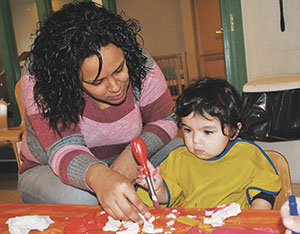Somerville braces for sequester impact
*

The recent federal spending cuts mean that 12 Somerville families will be cut from the Early Head Start program. – Photo courtesy Riverside Early Head Start
By Elizabeth Sheeran
The long-dreaded sequester is here, as Congressional deadlock triggered broad federal spending cuts beginning last Friday, March 1. It’s obviously not a good time to be counting on a steady paycheck from the federal government. But what does all this mean for Somerville?
A roundup of a few local programs impacted by the sequester suggests that our most vulnerable citizens will feel much of the pain: the oldest, the youngest and the poorest among us.
Seniors
The cuts are going to mean nearly 4,200 fewer meals for local seniors this year, according to Mary Ann Dalton, assistant director of Somerville-Cambridge Elder Services. That includes cuts in meal deliveries for those who can’t get out to get food on their own. And sequestration will cut all kinds of other services for the elderly in Somerville, like legal aid and transportation.
Dalton said the agency is still awaiting word on when cuts will kick in, and hasn’t decided how best to ration services, but she’s already seeing a lot of fear and anxiety among local seniors. She said the cuts don’t make a lot of sense in the big picture, since these programs help the elderly stay in their own homes, and prevent the enormous costs that come with institutional care.
“If they’re struggling at home and they can’t get food, they end up getting sick,” said Dalton. “They end up going into the hospital or potentially a nursing home at $100,000 a year, that all ends up being paid for by Medicaid. It’s silly and short-sighted, because in the end it costs so much more money.”
School-aged children
School Finance Director Pat Durette projects a quarter-million-dollar hit to next year’s budget from cuts to federal grants that support special education, low-income students, English language-learners and vocational training. Durette said the School Department will have to look at those programs during the upcoming budget process and decide if it needs to cut them or find the money to keep them, either by cutting something else, or asking for more money from the City. “$250,000 is a lot of money to try to make up,” said Durette.
Preschoolers
Local Head Start Director Donna Cabral got the news in a Friday conference call from the U.S. Department of Health and Human Services: a mandatory five percent budget cut for Head Start, which provides preschool and family support for 355 three, four and five-year-olds whose families live at or below the poverty line. By Monday morning, Cabral was huddled with Lynne Molnar of the Community Action Agency of Somerville, which oversees Head Start locally, looking for the least bad option to pursue.
Molnar said they are trying to protect children currently enrolled in the program, but that probably means ending the school year earlier, which will put an added burden on families already struggling to make ends meet. Next school year, they may have to take fewer children. She said they were looking for other places to cut. But options are limited because most costs (like teachers) are tied to enrollment.
“There are really only two options, to cut the number of kids served, or the number of weeks we’re open,” said Molnar. “We’re trying to find other ways to mitigate the cost reductions, but there’s very little give within our program. There’s very little fat. We’re on the bones of what we were doing anyway, so now you really have to cut services to children and families.”
Pregnant mothers, infants and toddlers
The five percent cut also applies to Early Head Start, which provides low-income families with care and support during pregnancy and the infant and toddler years. Because of the sequester, Riverside Community Care will have to completely eliminate one of its Early Head Start staff positions in Somerville, which in turn means it will have to drop 12 of the 94 families it currently serves.
Like families affected by cuts in Head Start, all of the Early Head Start families are living below the poverty line, which is under $24,000 for a family of four.
“The impact is that there are 12 low-income families that are not going to be able to get the care that they deserve, to give their children the support they need in terms of promoting healthy prenatal care and the well-being of the entire family, and giving the infants and toddlers a head start in their intellectual, social and emotional development,” said Riverside Associate Director Marjie McDaniel.
The homeless
At the Somerville Homeless Coalition (SHC), Director Mark Alston-Follansbee said the agency is in a state of stressful “limbo” as it awaits specific news from the federal Department of Housing and Urban Development, which provides half of the SHC’s $3 million annual budget. But he has heard that cuts could be as high as 10 percent.
“I’m worried, because 10 percent for us is $150,000 and we can’t sustain that. We would have to make drastic cuts to our programming at the same time that the need for our services has increased,” said Alston-Follansbee. He said even half that number could cripple a small agency like SHC, which provides transitional housing for 175 Somerville residents, along with emergency shelters.
“We’re not going to jump to conclusions until we have something tangible to respond to, but we’re constantly trying to think of how we are going to respond,” said Alston-Follansbee.” Would we have to lease fewer apartments? Would we have to close programs? Everything would have to be on the table. It’s frightening.”
For organizations who serve our more vulnerable citizens, it looks like those kinds of tough choices are going to be a fact of life for the foreseeable future.















Reader Comments